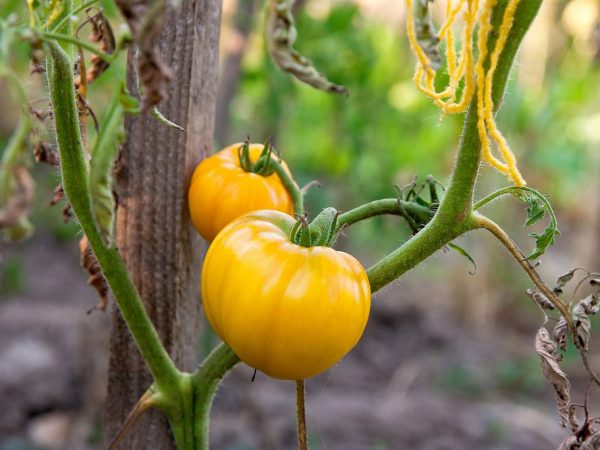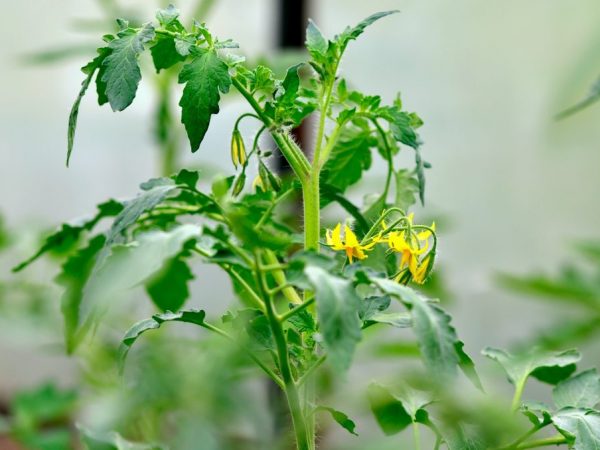Characteristics of the varieties of tomatoes Golden King and Golden Queen
The Golden Queen tomato, like the Golden King tomato, is well known to many vegetable growers. Despite the fact that these are relatively new varieties, which, according to official data, appeared less than 10 years ago. The main feature of the "queen" is that, unlike ordinary tomatoes, it is hypoallergenic, so it is ideal for children and diet food. The "king", in turn, has excellent characteristics, thanks to which it is used to obtain juice.

Characteristics of the varieties of tomatoes Golden King and Golden Queen
Varietal characteristics
Tomato "Golden Queen" was bred so that everyone could grow this nightshade, regardless of the climatic features of the area. Therefore, it can be concluded that the breeders have developed a frost-resistant crop.
Description of the variety
Tomatoes "Zolotaya Koroleva" have the following description of the variety: a hybrid, highly productive crop, it, like the tomato "Severnaya Koroleva", can be grown both in open space and in greenhouses (greenhouses). This is an indeterminate plant, that is, the plant has unlimited growth of the main stem, therefore, in greenhouse conditions, it can grow for more than 12 months. "King", in turn, has the following characteristics: he is also a hybrid, but medium early, in addition from the moment of planting to the beginning of the harvest 3 months. Therefore, he, like the Siberian, is included in the "early ripening" category.
Description of the bush
The "Golden Queen" as well as the "Golden King" have several identical parameters.
Among them is the height of the plant, in “Queen's” it is from 70-75 centimeters to 1 meter. The bush is moderately spreading, leaves are rich emerald, medium in size. At the "King" the bush reaches 1.00 m. It is quite large in size, belongs to the standard type, which tolerates diseases well.
Description of fruits
This is a really worthwhile strain that can be grown for further processing and for home use. The fruits have the following description:
- They have a round - flat or heart-shaped shape, there is a pronounced ribbing in the area of the stalk, ripen in brushes of 2-4 pieces each.
- Initially, their color is light green, in a short amount of time it acquires a rich yellow tint, hence the name "Golden". It happens that the tomato takes on a slightly different shade and turns yellow-orange.
- The pulp is moderately firm, fleshy, aromatic, juicy, with few seeds.
- The tomato is large, weighing on average 500 - 600 grams, but there are also very large tomatoes - giants, the weight of which exceeds 850-900 grams.
- The Golden Queen tomato is rich in vitamins and minerals, due to their high content, like the Victoria variety, the vegetable is recommended to be consumed fresh.
- Productivity: high from a plot of 1 square meter is harvested from 8 to 10 kilograms of tomatoes.This indicator in greenhouse conditions and in the open field is approximately the same.
The tomato is suitable for fresh consumption; it is used for making baby food, as well as a delicious and sweet juice.
The fruits of this tomato have unique taste characteristics, but one of the main disadvantages is that “Golden” varieties are not suitable for conservation, the fruits are very large in size. But some owners grow them exclusively for salting in a barrel.
Features of growing seedlings
These two varieties have almost identical characteristics, so their planting and care rules are also similar. Before planting, it is necessary to prepare both the soil and the seeds. To do this, the gardener performs the following manipulations:
Planting seeds

The plant does not require special care
The beginning of planting seeds falls in the second half of March. Before planting, they are soaked for a day in a growth stimulator. It is good if the soil consists of garden soil interspersed with organic and mineral fertilizers. For sowing seeds, a small depression is made, then the planting site is irrigated with water and, for a better temperature background, is covered from above with a film.
Sprout care
As soon as the first shoots appear, the seedlings must be provided with good lighting. To do this, it is either placed on a windowsill closer to natural light. If the weather is cloudy, then fluorescent lamps are used as an additional source. The ambient temperature should be at least 18 - 20 degrees Celsius, only under such conditions the culture develops without deviations.
Transplanting
When the first leaves appear, the soil is prepared in an open space. So that the plant is not affected by diseases, the earth is fertilized with special fertilizers, both organic and inorganic. Another important point of this stage is picking, that is, each sprout is transplanted into a separate container in order to strengthen the root system.
Planting in the garden is performed at the end of April and beginning of May, when the soil is warm enough and there are no strong temperature fluctuations. Three plants can be planted per square meter, no more, as this will significantly reduce the yield. The bushes form in 1 or 2 stems, if deformed flowers appear, then they must be removed immediately.
Fertilizer
To obtain a rich harvest, during the period of intensive growth, it is best to use inorganic (nitrogen or phosphate fertilizers). And during fruiting, it is better if the top dressing consists of organic fertilizers, which practically have no negative effect.
Watering
It is imperative to additionally water the vegetable growers of the southern strip, where drought is a frequent occurrence. But it is also impossible to flood the plant too much, since the formed environment can become an ideal place for the development of diseases. It will be optimal once a week, before the start of fruiting, during ripening it is better to increase the amount of irrigation, up to 1 p. in a few days.
Diseases
The most common diseases that can affect a plant are fungal in nature. White, gray or brown rot destroys not only the stem, but also the fruit itself, making it unusable. Another pest will be a spider mite, which causes the bush to dry out.
You should also be wary of the tobacco mosaic virus, which destroys the plant in a minimum time.
Prophylaxis
- Late blight, treatment of the culture with copper-containing or saline solutions.
- White rot does not develop if irrigation with "Fitosporin" is carried out. Gray for her is enough to systematize watering. Preventive measures for brown rot: optimize the use of organic fertilizers.
- To get rid of the tick, you need to destroy the weeds that are nearby, dig up the soil and treat it with Fitover.
Conclusion
According to the reviews of experienced vegetable growers, the “Golden King” and “Golden Queen” tomatoes are ideal varieties, breeding that can be done even by those who have not previously been involved in such a business. The main condition is to comply with all stages and rules of cultivation.


